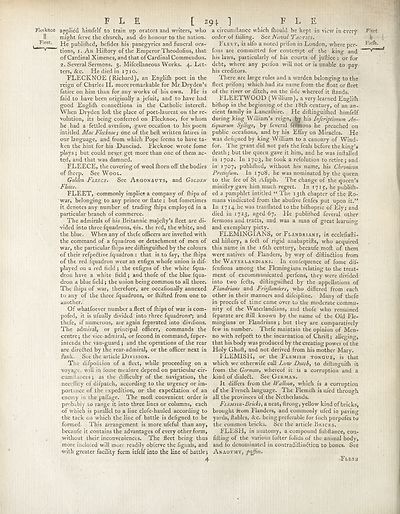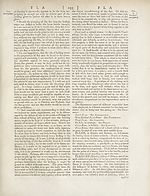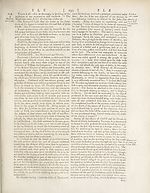Encyclopaedia Britannica > Volume 7, ETM-GOA
(320) Page 294 - FLE
Download files
Complete book:
Individual page:
Thumbnail gallery: Grid view | List view

F L E [ 294 ] F L E
applied himfelf to train up orators and writers, who
might ferve the church, and do honour to the nation.
He publilhed, befides his panegyrics and funeral ora¬
tions, 1. An Hiftory of the Emperor Theodofius, that
of Cardinal Ximenes, and that of Cardinal Commendon.
2. Several Sermons. 3. Mifcellaneous Works. 4. Let¬
ters, &c. He died in 1710.
FLECKNOE (Richard), an Englilh poet in the
reign of Charles II. more remarkable for Mr Dryden’s
fatire on him than for any works of his own. He is
faid to have been originally a jefuit, and to have had
good Englifh connexions in the Catholic interell.
When Dryden loft the place of poet-laureat on the re¬
volution, its being conferred on Flecknoe, for whom
he had a fettled averfion, gave occafion to his poem
intitled Mac Flecknoe; one of the belt written fatires in
our language, and from which Pope feems to have ta¬
ken the hint for his Dunciad. Flecknoe wrote fome
plays; but could never get more than one of them ac¬
ted, and that was damned.
FLEECE, the covering of wool (horn off the bodies
of ftieep. See Wool.
Golden Fleece*. See Argonauts, and Golden
Fleece.
FLEET, commonly implies a company of ftiips of
war, belonging to any prince or ftate : but fometimes
it denotes any number of trading (hips employed in a
particular branch of commerce.
The admirals of his Britannic majefty’s fleet are di¬
vided into three fquadrons, vi%. the red, the white, and
the blue. When any of thefe officers are invefted with
the command of a fquadron or detachment of men of
war, the particular (hips are diftinguiflred by the colours
of their refpeXive fquadron : that is to fay, the ftiips
of the red fquadron wear an enfign whofe union is dif-
played on a red field ; the enfigns of the white fqua¬
dron have a white field; and thofe of the blue fqua¬
dron a blue field; the union being common to all threei
The fliips of war, therefore, are occafionally annexed
to any of the three fquadrons, or fhifted from one to
another.
Of whatfoever number a fleet of fliips of war is com-
pofed, it is ufually divided into three fquadrons"; and
thefe, if numerous, are again feparated into divifions.
The admiral^ or principal officer, commands the
centre; the vice-admiral, or fecond in command, fuper-
intends the van-guard ; and the operations of the rear
are directed by the rear-admiral, or the officer next in
fank. See the article Division.
The difpofition of a fleet, while proceeding on a
voyage will in fome meafure depend on particular cir-
cumitances; as the difficulty of the navigation, the
neceffity of difpatch, according to the urgency or im¬
portance of the expedition, or the expectation of an
enemy in the paffage. The moft convenient order is
probabiy to range it into three lines or columns, each
of which is parallel to a line clofe-hauled according to
the tack on which the line of battle is defigned to be
formed This arrangement is more ufeful than any,
becaufe it contains the advantages of every other form,
without their inconveniences. The fleet being thus
more iiicloled will more readily obferve the fignals, and
with greater facility form itfelf into the line of battle;
4
a circuniftance which fhould be kept in view in every Fiect
order of failing. See Naval Tactics. Il
Fleet, is alfo a noted prifon in London, where per-
fons are committed for contempt of the king and
his laws, particularly of his courts of juftice : or for
debt, where any perfon will not or is unable to pay
his creditors.
There are large rules and a warden belonging to the
fleet prifon; which had its name from the float or fleet
of the river or ditch, on the fide whereof it ftands.
FLEETWOOD (William), a very learned Engliffi
biftiop in the beginning of the 18th century, of an an¬
cient family in Lancaffiire. He diftinguilhed himfelf
during king William’s reign, by his Infcriptionum An¬
tiquarian Sylloge, by feveral fermons he preached on
public occafions, and by his Effay on Miracles. He
was defigned by king William to a canonry of Wind-
for. The grant did not pafs the feals before the king’s
death; but the queen gave it him, and he was inftalled
in 1702. In 1703, he took a refolution to retire ; and
in 1707, publifhed, without his name, his Chronicon
Pretiofum. In 1708, he was nominated by the queen
to the fee of St Afaph. The change of the queen’s
miniftrygave him much regret. In 1715, he publifh¬
ed a pamphlet intitled “ The 13 th chapter of the Ro¬
mans vindicated from the abufive fenfes put upon it.”
In 1714 he was tranflated to the bilhopric of Ely; and
died in 1723, aged 67. He publifhed feveral other
fermons and traXs, and was a man of great learning
and exemplary piety.
FLEMINGIANS, or Flandrians, in ecclefiafti-
cal hiftory, a feX of rigid anabaptifts, who acquired
this name in the 16th century, becaufe moft of them
were natives of Flanders, by way of diftinXion from
the Waterlandians. In confequence of fome dif-
fenfions among the Flemingians relating to the treat¬
ment of excommunicated perfons, they were divided
into two feXs, diftinguilhed by the appellations of
Flandrians and Friejlanders, who differed from each
other in their manners and difeipline. Many of thefe
in procefs of time came over to the moderate commu¬
nity of the Waterlandians, and thofe who remained
feparate are ftill known by the name of the Old Fle¬
mingians or Flandrians ; but they are comparatively
few in number. Thefe maintain the opinion of Men-
no with refpeX to the incarnation of Chrift; alleging,
that his body was produced by the creating power of the
Holy Ghoft, and not derived from his mother Mary.
FLEMISH, or the Flemish tongue, is that
which we otherwife call Low Dutch, to diftinguifh it
from the German, whereof it is a corruption and a
kind of dialeX. See German.
It differs from the Walloon, which is a corruption
of the French language. The Flemilh is ufed through
all the provinces of the Netherlands.
Flemish-Bricks, a neat, ftrong, yellow kind of bricks,
brought from Flanders, and commonly ufed in paving
yards, ftables, &c. being preferable for Inch purpofes to
the common bricks. See the article Bricks.
FTESH, in anatomy, a compound fubftance, con-
fifting of the various fofter folids of the animal body,
and fo denominated in contradiftinXion to bones. See
Anaotmy, pajfim.
Flesh
applied himfelf to train up orators and writers, who
might ferve the church, and do honour to the nation.
He publilhed, befides his panegyrics and funeral ora¬
tions, 1. An Hiftory of the Emperor Theodofius, that
of Cardinal Ximenes, and that of Cardinal Commendon.
2. Several Sermons. 3. Mifcellaneous Works. 4. Let¬
ters, &c. He died in 1710.
FLECKNOE (Richard), an Englilh poet in the
reign of Charles II. more remarkable for Mr Dryden’s
fatire on him than for any works of his own. He is
faid to have been originally a jefuit, and to have had
good Englifh connexions in the Catholic interell.
When Dryden loft the place of poet-laureat on the re¬
volution, its being conferred on Flecknoe, for whom
he had a fettled averfion, gave occafion to his poem
intitled Mac Flecknoe; one of the belt written fatires in
our language, and from which Pope feems to have ta¬
ken the hint for his Dunciad. Flecknoe wrote fome
plays; but could never get more than one of them ac¬
ted, and that was damned.
FLEECE, the covering of wool (horn off the bodies
of ftieep. See Wool.
Golden Fleece*. See Argonauts, and Golden
Fleece.
FLEET, commonly implies a company of ftiips of
war, belonging to any prince or ftate : but fometimes
it denotes any number of trading (hips employed in a
particular branch of commerce.
The admirals of his Britannic majefty’s fleet are di¬
vided into three fquadrons, vi%. the red, the white, and
the blue. When any of thefe officers are invefted with
the command of a fquadron or detachment of men of
war, the particular (hips are diftinguiflred by the colours
of their refpeXive fquadron : that is to fay, the ftiips
of the red fquadron wear an enfign whofe union is dif-
played on a red field ; the enfigns of the white fqua¬
dron have a white field; and thofe of the blue fqua¬
dron a blue field; the union being common to all threei
The fliips of war, therefore, are occafionally annexed
to any of the three fquadrons, or fhifted from one to
another.
Of whatfoever number a fleet of fliips of war is com-
pofed, it is ufually divided into three fquadrons"; and
thefe, if numerous, are again feparated into divifions.
The admiral^ or principal officer, commands the
centre; the vice-admiral, or fecond in command, fuper-
intends the van-guard ; and the operations of the rear
are directed by the rear-admiral, or the officer next in
fank. See the article Division.
The difpofition of a fleet, while proceeding on a
voyage will in fome meafure depend on particular cir-
cumitances; as the difficulty of the navigation, the
neceffity of difpatch, according to the urgency or im¬
portance of the expedition, or the expectation of an
enemy in the paffage. The moft convenient order is
probabiy to range it into three lines or columns, each
of which is parallel to a line clofe-hauled according to
the tack on which the line of battle is defigned to be
formed This arrangement is more ufeful than any,
becaufe it contains the advantages of every other form,
without their inconveniences. The fleet being thus
more iiicloled will more readily obferve the fignals, and
with greater facility form itfelf into the line of battle;
4
a circuniftance which fhould be kept in view in every Fiect
order of failing. See Naval Tactics. Il
Fleet, is alfo a noted prifon in London, where per-
fons are committed for contempt of the king and
his laws, particularly of his courts of juftice : or for
debt, where any perfon will not or is unable to pay
his creditors.
There are large rules and a warden belonging to the
fleet prifon; which had its name from the float or fleet
of the river or ditch, on the fide whereof it ftands.
FLEETWOOD (William), a very learned Engliffi
biftiop in the beginning of the 18th century, of an an¬
cient family in Lancaffiire. He diftinguilhed himfelf
during king William’s reign, by his Infcriptionum An¬
tiquarian Sylloge, by feveral fermons he preached on
public occafions, and by his Effay on Miracles. He
was defigned by king William to a canonry of Wind-
for. The grant did not pafs the feals before the king’s
death; but the queen gave it him, and he was inftalled
in 1702. In 1703, he took a refolution to retire ; and
in 1707, publifhed, without his name, his Chronicon
Pretiofum. In 1708, he was nominated by the queen
to the fee of St Afaph. The change of the queen’s
miniftrygave him much regret. In 1715, he publifh¬
ed a pamphlet intitled “ The 13 th chapter of the Ro¬
mans vindicated from the abufive fenfes put upon it.”
In 1714 he was tranflated to the bilhopric of Ely; and
died in 1723, aged 67. He publifhed feveral other
fermons and traXs, and was a man of great learning
and exemplary piety.
FLEMINGIANS, or Flandrians, in ecclefiafti-
cal hiftory, a feX of rigid anabaptifts, who acquired
this name in the 16th century, becaufe moft of them
were natives of Flanders, by way of diftinXion from
the Waterlandians. In confequence of fome dif-
fenfions among the Flemingians relating to the treat¬
ment of excommunicated perfons, they were divided
into two feXs, diftinguilhed by the appellations of
Flandrians and Friejlanders, who differed from each
other in their manners and difeipline. Many of thefe
in procefs of time came over to the moderate commu¬
nity of the Waterlandians, and thofe who remained
feparate are ftill known by the name of the Old Fle¬
mingians or Flandrians ; but they are comparatively
few in number. Thefe maintain the opinion of Men-
no with refpeX to the incarnation of Chrift; alleging,
that his body was produced by the creating power of the
Holy Ghoft, and not derived from his mother Mary.
FLEMISH, or the Flemish tongue, is that
which we otherwife call Low Dutch, to diftinguifh it
from the German, whereof it is a corruption and a
kind of dialeX. See German.
It differs from the Walloon, which is a corruption
of the French language. The Flemilh is ufed through
all the provinces of the Netherlands.
Flemish-Bricks, a neat, ftrong, yellow kind of bricks,
brought from Flanders, and commonly ufed in paving
yards, ftables, &c. being preferable for Inch purpofes to
the common bricks. See the article Bricks.
FTESH, in anatomy, a compound fubftance, con-
fifting of the various fofter folids of the animal body,
and fo denominated in contradiftinXion to bones. See
Anaotmy, pajfim.
Flesh
Set display mode to:
![]() Universal Viewer |
Universal Viewer | ![]() Mirador |
Large image | Transcription
Mirador |
Large image | Transcription
Images and transcriptions on this page, including medium image downloads, may be used under the Creative Commons Attribution 4.0 International Licence unless otherwise stated. ![]()
| Encyclopaedia Britannica > Encyclopaedia Britannica > Volume 7, ETM-GOA > (320) Page 294 - FLE |
|---|
| Permanent URL | https://digital.nls.uk/189125389 |
|---|
| Attribution and copyright: |
|
|---|
| Description | Ten editions of 'Encyclopaedia Britannica', issued from 1768-1903, in 231 volumes. Originally issued in 100 weekly parts (3 volumes) between 1768 and 1771 by publishers: Colin Macfarquhar and Andrew Bell (Edinburgh); editor: William Smellie: engraver: Andrew Bell. Expanded editions in the 19th century featured more volumes and contributions from leading experts in their fields. Managed and published in Edinburgh up to the 9th edition (25 volumes, from 1875-1889); the 10th edition (1902-1903) re-issued the 9th edition, with 11 supplementary volumes. |
|---|---|
| Additional NLS resources: |
|

